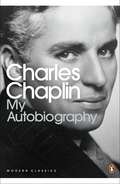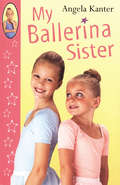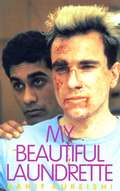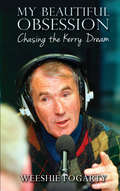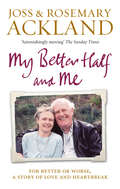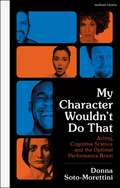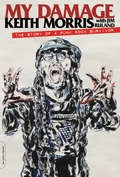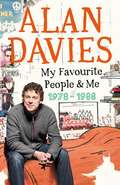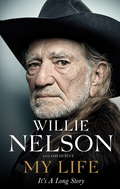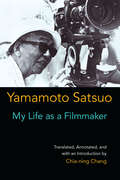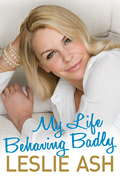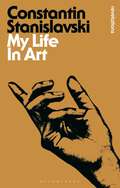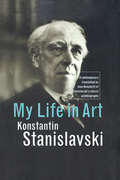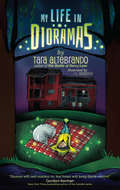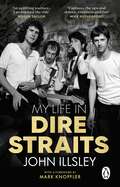- Table View
- List View
My Autobiography (Penguin Modern Classics)
by David Robinson Charles ChaplinBorn into a theatrical family, Chaplin's father died of drink while his mother, unable to bear the poverty, suffered from bouts of insanity, Chaplin embarked on a film-making career which won him immeasurable success, as well as intense controversy. His extraordinary autobiography was first published in 1964 and was written almost entirely without reference to documentation - simply as an astonishing feat of memory by a 75 year old man. It is an incomparably vivid reconstruction of a poor London childhood, the music hall and then his prodigious life in the movies.
My Ballerina Sister (Red Fox Ballet Books)
by Angela KanterEmmy loves ballet but she isn't old enough to dance in her sister Charlotte's class. Then one day when she comes to watch the lesson she can't resist joining in. Before anyone realises, Emmy's doing pli-s at the barre - and she's doing them very well! Most of the class are thrilled by her dancing, but Charlotte isn't quite so comfortable about having a little sister who seems set to steal her limelight. When Emmy is given the coveted role of Spring in the annual show it seems the final straw for Charlotte, but then her teacher helps her to understand that although Emmy is very talented for her age, she can't dance as well as Charlotte, and Charlotte ought to feel proud that Emmy has learnt so much from watching her talented big sister.
My Ballerina Sister On Stage (Red Fox Ballet Books)
by Angela KanterCharlotte is in for a nasty surprise when Emmy makes a new friend, Tom. For Tom's big sister, Icky Nicky, is in Charlotte's ballet class - and they hate each other! But when their sisters' fighting starts to get in the way of Tom and Emmy's friendship, they must find a way of bringing their warring siblings together, and ballet could be just the thing they need. And to Charlotte and Nicky's surprise, they soon find they have a lot more in common than they had realised.
My Bass and Other Animals
by Guy PrattGuy Pratt's life as bass player to the stars. The book behind the successful comedy show.Guy Pratt came of age just as playing bass became cool, with the likes of Paul Simonon and Bruce Foxton. Having dallied with Funkapolitan, Pratt suddenly found himself on Top of the Pops and supporting David Bowie with smooth Australian outfit Icehouse. At a ludicrously young age Guy Pratt became a sought after bass player to the stars, finding himself crawling from studio to bar, from hotel to stadium portacabin with Robert Palmer, Womack & Womack, Bernard Edwards, Bryan Ferry and David Crosby, etc. The eighties were in their prime, and with a number of Crolla-suited appearances in windswept videos behind him, he was invited to join Pink Floyd for a series of stadium of extravaganzas to make Bono & co look fairly modest. Pratt has recorded with Madonna, and spent time in the studio with Michael Jackson. He was in The Smiths for a week, has travelled through customs in a wheelchair after a flight with Jimmy Page, and has lived to tell all. MY BASS AND OTHER ANIMALS emerges from the successful stand-up tour of the same name. It charts his journey from a Mod band in Southend to playing with Roxy Music at Live 8.
My Beautiful Laundrette: Turner Classic Movies British Film Guide (British Film Guides)
by Christine GeraghtyMy Beautiful Laundrette is a phenomenon, a small television film which became a political and social landmark, a classic which speaks to audiences today. It is a gay romance, a lesson in ethnic diversity, a riposte to Thatcherite principles and a celebration of the edgy possibilities of London in the 1980s. A crucial film for director Stephen Frears and writer Hanif Kureishi, it put Daniel Day-Lewis on the map and reshaped Saeed Jaffrey's career. Christine Geraghty traces out how the film came to have this status. She connects it to crucial debates about black cinema and identity but more generally explores its reputation as a mythic film which pushed at the boundaries of what was possible. This is an exemplary study of the cultural forces of production and reception which make and mould a film. Geraghty does not neglect the film's aesthetic pleasures and gives a detailed account of the film's narrative, mise-en-scene and performances. She shows how it becomes a celebration of cinema as a utopian space, a site of transforming and life-enhancing activity. This book illuminates My Beautiful Laundrette, providing an accessible account for new viewers and a rewarding exploration for those who already know it.
My Beautiful Laundrette: My Beautiful Laundrette; Sammy And Rosie Get Laid; London Kills Me; My Son The Fanatic
by Hanif KureishiOmar is a restless young Asian man, caring for his alcoholic father in the hustling London of the mid-1980s. His uncle, a keen Thatcherite, offers Omar an entrepreneurial opportunity to revamp a dingy laundrette, and ambitious Omar rolls up his sleeves, enlisting the assistance of his old school-friend Johnny, who has since fallen in with a gang of neo-fascists. Omar and Johnny soon form an unlikely alliance that leads to business success, as well as other, more intimate surprises.
My Beautiful Obsession - Chasing the Kerry Dream: Chasing The Kerry Dream
by Weeshie FogartyA fascinating account of the life and career of Weeshie Fogarty, describing the passion and all-consuming obsession with football in Kerry and capturing the importance of the sport in the life of a youngster in Killarney in the 1950s. After his dream of playing with Kerry in Croke Park comes true, Weeshie becomes an intercounty referee and experiences the trauma of assault. Some secrets of Kerry football are revealed and some controversial moments. Today, he is an award-winning sports broadcaster with Radio Kerry. Into this memoir he weaves an account of life as a psychiatric nurse in a Victorian-style mental hospital.
My Better Half and Me: For Better Or Worse, A Story Of Love And Heartbreak
by Joss Ackland Rosemary AcklandRosemary Ackland began writing her diary in 1945, aged just fifteen. For the next fifty-eight years, through happiness and heartache, she continued to write. Even after the tragic onset of Motor Neurone disease, which left her mute and immobile, her diary was still an outlet - in fact, then more than ever. Her simple, heartfelt jottings were never intended for an audience. But, during her last days, as he helped her hold a pen, her husband Joss read her words for the first time. Deeply moved by her lifetime's recollections he asked her consent to publish them and she agreed. My Better Half and Me weaves together Rosemary's diaries with Joss's commentary to tell of an extraordinary love story that lasted over fifty years. Their life together was remarkably full. At first they lived on a shoestring, struggling to bring up their new family on just Joss's payas a young actor. Once his career took off their lives became a dynamic whirl of tours across the country. But they remained an extremely close-knit family, with lives shaped by their seven children, by the tragic, untimely death of their eldest son, and later, by the birth of their grandchildren. Above all, this intimate and candid story, shows how lucky they were to have each other. In turbulent times they were each other's rock. Theirs was truly and old-fashioned romance.
My Character Wouldn’t Do That: Acting, Cognitive Science and the Optimal Performance Brain
by Donna Soto-MorettiniStarting from the idea that the main hindrance to a great acting performance is self-consciousness on the part of the performer, My Character Wouldn't do That examines the ways in which some of our traditional and contemporary approaches to acting put us into a 'mind space' that can encourage self-consciousness. Examining evidence from a range of contemporary cognitive sciences, the book approaches acting and actor training in an entirely different way. Based on the latest research into brain activity and human behaviour, the book covers areas that standard acting texts do (character, emotion, memory, imagination, making active choices) but reconceives each of these elements through the lens of that contemporary research. The book is the first to look closely at what contemporary research tells us about:· personality/character and how environment shapes us· how memory works and how actors can work with (rather than against) their memory in preparing for performance· why actors must use different kinds of brain states and imagination in the various stages of preparation, rehearsal, and performance· how actors can frame active choices in a way that refocuses the source of thought and action· why actors should distinguish the stages of preparation and the kinds of thinking / imagination that works at each stage
My Character Wouldn’t Do That: Acting, Cognitive Science and the Optimal Performance Brain
by Donna Soto-MorettiniStarting from the idea that the main hindrance to a great acting performance is self-consciousness on the part of the performer, My Character Wouldn't do That examines the ways in which some of our traditional and contemporary approaches to acting put us into a 'mind space' that can encourage self-consciousness. Examining evidence from a range of contemporary cognitive sciences, the book approaches acting and actor training in an entirely different way. Based on the latest research into brain activity and human behaviour, the book covers areas that standard acting texts do (character, emotion, memory, imagination, making active choices) but reconceives each of these elements through the lens of that contemporary research. The book is the first to look closely at what contemporary research tells us about:· personality/character and how environment shapes us· how memory works and how actors can work with (rather than against) their memory in preparing for performance· why actors must use different kinds of brain states and imagination in the various stages of preparation, rehearsal, and performance· how actors can frame active choices in a way that refocuses the source of thought and action· why actors should distinguish the stages of preparation and the kinds of thinking / imagination that works at each stage
My Damage: The Story of a Punk Rock Survivor
by Keith MorrisHardcore punk memoir by Keith Morris, ultimate punk rock frontman and founder of Black Flag, the Circle Jerks, and OFF!Keith Morris is a true punk icon. Over the course of his forty-year career with Black Flag, the Circle Jerks, and OFF!, he's battled diabetes, drug and alcohol addiction, and the record industry...and he's still going strong. More than a book about the highs and lows of a punk rock legend, My Damage is a story from the perspective of someone who has shared the stage with just about every major figure in the music industry and has appeared in cult films like The Decline of Western Civilization and Repo Man. A true Hollywood tale from an L.A. native, My Damage reveals the story of Morris's streets, his scene, and his music--as only he can tell it.
My Family: The Memoir
by null David Baddiel'Genuinely one of the funniest books I have ever read. I wept with laughter' HADLEY FREEMAN ‘Baddiel has made true art out of experience … A masterpiece’ SATHNAM SANGHERA 'Laugh out loud funny … The read of the summer' THE SUNDAY TIMES A searingly honest, funny and moving family memoir in which David Baddiel exposes his mother’s idiosyncratic sex life, and his father’s dementia, to the same affectionate scrutiny On the surface, David Baddiel’s childhood was fairly standard: a lower-middle-class Jewish family living in an ordinary house in Dollis Hill, north-west London. But David came to realise that his mother was in fact not ordinary at all. Having escaped extermination by fleeing Nazi Germany as a child, she was desperate to make her life count, which took the form of a passionate, decades-long affair with a golfing memorabilia salesman. David’s detailing of the affair – including a hilarious focus on how his mother turned their household over to golf memorabilia, and an eye-popping cache of her erotic writings – leads to the inescapable conclusion that Sarah Baddiel was a cross between Jack Niklaus and Erica Jong. Meanwhile, as Baddiel investigates his family’s past, his father’s memories are fading; dementia is making him moodier and more disinhibited, with an even greater penchant for obscenity. As with his mother’s affair, there is both comedy and poignancy to be found: laughter is a constant presence, capable of transforming the darkest of experiences into something redemptive. My Family: The Memoir is David Baddiel’s candid examination of his childhood, family and memory offering a twisted love letter to his parents. 'Baddiel has done his parents proud’ GUARDIAN 'Such a blisteringly honest book it would set fire to the word "candid" for being too pathetic' CAITLIN MORAN
My Favourite People & Me: 1978-1988
by Alan DaviesAlan Davies was always a hoarder. Pages from Smash Hits, rolled up gig posters, Cup Final ticket stubs, Woody Allen paperbacks, NME covers and Blondie calendars filled boxes once used to ferry shopping home from supermarkets (back when supermarkets would leave boxes out for the ferrying of shopping). Not much that came down from Alan's bedroom wall made it into the bin, never mind the uninvented bin-liner.Growing up is not easy. So many decisions: Who to revere, Sheene or McEnroe? Who to imitate, Starsky or Hutch? Who to dislike overnight in an effort to show maturity, Thatcher or Scargill? How to decide which pin-ups to unpin when a batch of Animal Rights leaflets or a satirical poster of Ronald Reagan demand wallspace?The Impressionable Age of a young man lasts around a decade and the idols and icons of that period can reveal much of the time and of the impressed subject.Nostalgic, warm and laugh-out-loud funny My Favourite People and Me 1978-1988 is an affectionate trip through a suburban childhood in Essex and an eighties education in Kent. As Alan says, 'an attempt to remember who and what I liked as a boy/youth/idiot and to work out why. There are also some pictures.'
My Heart is Bleeding: The Life of Dorothy Squires
by Johnny TudorAs a young girl toiling in a South Wales tin works, Dorothy Squires dreamt of being a singing star, but was ridiculed by all around her. At the tender age of sixteen she escaped the valleys and boarded a train for London. It was here that she met and fell in love with songwriter and band leader Billy Reid, the older man who was to make her a star. The pair became an international success, but the relationship foundered, and Dorothy found herself falling in love with the much younger Roger Moore, a struggling actor who she would spend all her time establishing as a star. Written by Dorothy’s good friend JOHNNY TUDOR, this fascinating first biography of a Welsh singing phenomenon is an unprecedented insight into the glitz and glamour of 1940s and ’50s Hollywood and Dorothy’s triumphant comeback in the 1960s and ’70s.
My Lady Parts: A Life Fighting Stereotypes
by Doon MackichanThe Feisty Feminist. The Hot Lesbian. The Desperate Cougar. The Deranged Mother. Doon Mackichan is best known for her comedy characters, but throughout her career there are parts she’s refused to take and stereotypes she's continually defied.In My Lady Parts, Doon shares her experience on stage, screen and in real life, examining how our culture still expects women to adhere to certain stereotypes – and punishes those who don’t. This is a courageous, vulnerable and empowering account of being a woman in an industry that has been exposed for its deep-rooted sexism.
My Last Breath
by Luis BunuelA master filmmaker, inimitable, and unrelenting in his assault on bourgeois values. Bunuel's method is free from all artifice, and his honesty and humour are to extreme to accept any compromise in exposing our deceit and our decadence. Like Pasolini, his work offers a remarkably sophisticated political analysis, but remains based in the essentially peasant values of storytelling, and the purposefully unsystematic supervisions of laughter.
My Life: It's A Long Story
by Willie NelsonFive decades in the music industry, 100 albums, 10 Grammys, the Kennedy Center Honors, and the Country Music Hall of Fame. Add high-profile activism for the legalisation of marijuana, the foundation of a ground-breaking philanthropic organisation, and a much-publicised personal life - Willie Nelson's is a story like no other. Born during the great depression in 1933 and raised by his grandparents, he began singing in dance halls and Honky Tonks at the age of 13, as an escape from working as a cotton picker in the fields of Arkansas. He went on to write some of the most popular country songs of all time, and to record some classic versions of others, including Crazy, Bring Me Sunshine, Always on my Mind and Blue Eyes Crying in the Rain. An American icon who still tours extensively and headlines music festivals, Willie Nelson and his music have found their way into the hearts and minds of fans all over the world.Now 81 years of age, Nelson leaves no experience or moment unturned as he shares the full story. From his drive to write music to the women in his life; from his collaborations to his bankruptcy to the foundation of Farm Aid; Nelson shares, in his distinct voice, soaring highs and painful lows.
My Life as a Filmmaker (Michigan Monograph Series in Japanese Studies #80)
by Satsuo YamamotoIn his posthumous autobiography, Watakushi no eiga jinsei (1984), Yamamoto reflects on his career and legacy: beginning in the prewar days as an assistant director in a well-established film company under the master Naruse Mikio, to his wide-ranging experiences as a filmmaker, including his participation in the tumultuous Toho Labor Upheaval soon after Japan’s defeat in World War II and his struggles as an independent filmmaker in the 1950s and 1960s before returning to work within the mainstream industry. In the process, he established himself as one of the most prominent and socially engaged film artists in postwar Japan. Imbued with vibrant social realism and astute political commentary, his filmic genres ranged widely from melodramas, period films from the Tokugawa era, samurai action jidaigeki, social satires, and antiwar films. Providing serious insights into and trenchant critique of the moral corruption in Japanese politics, academe, industry, and society, Yamamoto at the same time produced highly successful films that offered drama and entertainment for Japanese and international moviegoers. His considerable artistic distinction, strong social and political consciousness, and filmic versatility have earned him a unique and distinguished position among Japan’s world-class film directors. In addition to detailed annotations of the autobiography, translator Chia-ning Chang offers a comprehensive introduction to the career and the significance of Yamamoto and his works in the context of Japanese film history. It contextualizes Yamamoto’s life and works in the historical and cultural zeitgeist of prewar, wartime, and postwar Japan before scrutinizing the unique qualities of his narrative voice and social conscience as a film artist.
My Life Behaving Badly: The Autobiography
by Leslie AshThe full and honest story from one of the UK's favourite celebrities, including her astonishing fightback from the superbug that nearly killed herLeslie Ash has been one of Britain's most popular actresses for many years now, having made her big break in the film 'Quadrophenia'. In the 1980s she starred in 'Cat's Eyes', but it is as Deb in 'Men Behaving Badly' that she is best known. Yet this hugely successful career is only a part of the story.Her marriage to Lee Chapman has been turbulent, as they lived (and partied) the celebrity lifestyle to the full. Viewed as a 'beaten' spouse, a blonde bimbo and the 'victim' of plastic surgery, she has been pigeon-holed by many but understood by few. Now, in her long-awaited memoirs, she tells the whole story from the day she first appeared on TV at four to advertise Fairy Liquid, through to her battle to recover from the superbug that nearly killed her and how it transformed her life and made her understand what is really important. Leslie now campaigns for better hygiene in hospitals. This is an astonishing, moving and yet very funny memoir.
My Life In Art (Bloomsbury Revelations)
by Constantin StanislavskiNo one has had a greater influence on acting as we know it than Stanislavski. His 'method' - or interpretations of it - has become the central force determining almost every performance we see on stage or screen. In My Life in Art Stanislavski recalls his theatrical career, from his early experiences in Rubinstein's Russian Musical Society to his final triumphs with Chekhov at the Moscow Art Theatre. His vivid accounts of his own most famous productions including 'The Seagul' and 'Uncle Vanya' are interspersed with anecdotes of the famous - of Kommisarjevksy, Tolstoy, Gorky, and of the Moscow visit of Isadora Duncan and Gordon Craig.
My Life In Art (Bloomsbury Revelations)
by Constantin StanislavskiNo one has had a greater influence on acting as we know it than Stanislavski. His 'method' - or interpretations of it - has become the central force determining almost every performance we see on stage or screen. In My Life in Art Stanislavski recalls his theatrical career, from his early experiences in Rubinstein's Russian Musical Society to his final triumphs with Chekhov at the Moscow Art Theatre. His vivid accounts of his own most famous productions including 'The Seagul' and 'Uncle Vanya' are interspersed with anecdotes of the famous - of Kommisarjevksy, Tolstoy, Gorky, and of the Moscow visit of Isadora Duncan and Gordon Craig.
My Life in Art
by Konstantin StanislavskiKonstantin Stanislavski was a Russian director who transformed theatre in the West with his contributions to the birth of Realist theatre and his unprecedented approach to teaching acting. He lived through extraordinary times and his unique contribution to the arts still endures in the twenty-first century. He established the Moscow Art Theatre in 1898 with, among other plays, the premiere of Chekhov's The Seagull. He also survived revolutions, lost his fortune, found wide fame in America, and lived in internal exile under Stalin's Soviet Union. Before writing his classic manual on acting, Stanislavski began writing an autobiography that he hoped would both chronicle his rich and tumultuous life and serve as a justification of his aesthetic philosophy. But when the project grew to 'impossible' lengths, his publisher (Little, Brown) insisted on many cuts and changes to keep it to its deadline and to a manageable length. The result was a version published in English in 1924, which Stanislavski hated and completely revised for a Soviet edition that came out in 1926. Now, for the first time, translator Jean Benedetti brings us Stanislavski's complete unabridged autobiography as the author himself wanted it – from the re-edited 1926 version. The text, in clear and lively English, is supplemented by a wealth of photos and illustrations, many previously unpublished.
My Life in Art
by Konstantin StanislavskiKonstantin Stanislavski was a Russian director who transformed theatre in the West with his contributions to the birth of Realist theatre and his unprecedented approach to teaching acting. He lived through extraordinary times and his unique contribution to the arts still endures in the twenty-first century. He established the Moscow Art Theatre in 1898 with, among other plays, the premiere of Chekhov's The Seagull. He also survived revolutions, lost his fortune, found wide fame in America, and lived in internal exile under Stalin's Soviet Union. Before writing his classic manual on acting, Stanislavski began writing an autobiography that he hoped would both chronicle his rich and tumultuous life and serve as a justification of his aesthetic philosophy. But when the project grew to 'impossible' lengths, his publisher (Little, Brown) insisted on many cuts and changes to keep it to its deadline and to a manageable length. The result was a version published in English in 1924, which Stanislavski hated and completely revised for a Soviet edition that came out in 1926. Now, for the first time, translator Jean Benedetti brings us Stanislavski's complete unabridged autobiography as the author himself wanted it – from the re-edited 1926 version. The text, in clear and lively English, is supplemented by a wealth of photos and illustrations, many previously unpublished.
My Life in Dioramas
by Tara AltebrandoKate Marino knows very well that home is where her heart is, and if she had any say in the matter, her heart would stay put in Big Red. The old, rambling farmhouse has withstood the test of time with her family, but now Kate's parents have decided to sell it from under her feet. The preventative solution: sabotage the realtor's tours with the help of best friends and a plan that has maximum stinkage potential. The back-up plan: hang on to at least a little bit of life at Big Red by creating shoebox dioramas of each room. But even with a full-scale assault, will her mission be a success? And if not, what will the diorama of Kate's future look like? With a keen eye for capturing the moments that matter, acclaimed author Tara Altebrando explores the pain-and promise-of letting go.CCSS-aligned curriculum guidecan be found online at http://www.rpcurriculumguides.com/curriculum_guides.html
My Life in Dire Straits: The Inside Story of One of the Biggest Bands in Rock History
by John IllsleyWith a foreword by MARK KNOPFLER'An uplifting journey through the sheer hard work, pitfalls and thrills of navigating a great rock band to the pinnacle of success. I so enjoyed the ride!' ROGER TAYLOR, Queen__________Dire Straits filled giant stadiums around the world and sold hundreds of millions of records. Throughout the eighties they were one of the biggest bands on the planet. Their classic songs - 'Sultans of Swing', 'Romeo and Juliet', 'Money for Nothing', 'Brothers In Arms' - formed the soundtrack of a generation and live on today: still racking up sales, still being played on the radio on every continent. In My Life in Dire Straits, John Illsley - founding member, bassist and mainstay - evokes the spirit of the times and tells the story of one of the great live acts of rock history.Starting with his own unlikely beginnings in Middle England, he recounts the band's rise from humble origins in London's spit-and-sawdust pubs to the best-known venues in the world, the working man's clubs to Madison Square Garden, gigging with wild punk bands to the Live Aid stage at Wembley. Until, ultimately, the shattering demands of touring on a global scale and living life in the spotlight took their inevitable toll.John's story is also a tribute to his great friend Mark Knopfler, the band's lead singer, songwriter and gifted guitarist - the only band members to stay the fifteen-year distance. Told with searching honesty, soulful reflection and wry humour, this is the first and only account of that incredible story.
